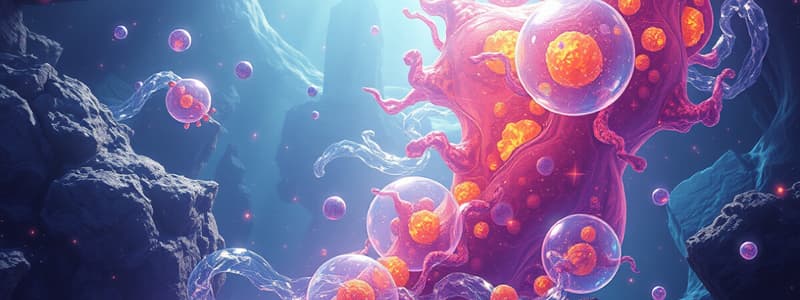Podcast
Questions and Answers
What is the total volume of Extracellular Fluid (ECF) in the body?
What is the total volume of Extracellular Fluid (ECF) in the body?
- 14 L (correct)
- 10.5 L
- 3.5 L
- 28 L
How much of the Total Body Water (TBW) constitutes the Intracellular Fluid (ICF)?
How much of the Total Body Water (TBW) constitutes the Intracellular Fluid (ICF)?
- 14 L
- 10.5 L
- 42 L
- 28 L (correct)
What percentage of the Extracellular Fluid (ECF) is represented by Plasma?
What percentage of the Extracellular Fluid (ECF) is represented by Plasma?
- 50%
- 60%
- 75%
- 25% (correct)
Which fluid compartment holds the largest volume in the body?
Which fluid compartment holds the largest volume in the body?
What fraction of the Total Body Water (TBW) is made up by Extracellular Fluid (ECF)?
What fraction of the Total Body Water (TBW) is made up by Extracellular Fluid (ECF)?
What is the total body water (TBW) for a 70kg adult male?
What is the total body water (TBW) for a 70kg adult male?
At what stage is the percent of total body water (TBW) the highest?
At what stage is the percent of total body water (TBW) the highest?
Which factor decreases the percent of total body water in humans?
Which factor decreases the percent of total body water in humans?
How does body fat percentage relate to total body water?
How does body fat percentage relate to total body water?
In terms of total body water percentage, how does an adult male compare to an equivalent female?
In terms of total body water percentage, how does an adult male compare to an equivalent female?
What is the primary movement of water in osmosis?
What is the primary movement of water in osmosis?
What is the osmolarity range for plasma?
What is the osmolarity range for plasma?
Which type of solution has an osmolarity lower than that of plasma?
Which type of solution has an osmolarity lower than that of plasma?
What primarily contributes to the osmolarity of intracellular fluid (ICF)?
What primarily contributes to the osmolarity of intracellular fluid (ICF)?
What defines osmotic pressure?
What defines osmotic pressure?
What defines an electrolyte?
What defines an electrolyte?
Which ion has the highest concentration in ECF compared to ICF?
Which ion has the highest concentration in ECF compared to ICF?
What is the primary distinguishing feature of osmolarity?
What is the primary distinguishing feature of osmolarity?
Which ion concentration is negligible in ICF?
Which ion concentration is negligible in ICF?
What is a key characteristic of osmotically active particles?
What is a key characteristic of osmotically active particles?
Flashcards are hidden until you start studying
Study Notes
Osmosis
- Water moves across a semipermeable membrane from low solute concentration to high solute concentration.
- All cell membranes and capillaries function as semipermeable membranes.
- Osmotic pressure is defined as the pressure that would prevent osmosis.
Osmolarity
- Plasma osmolarity ranges between 280-300 mosm/L.
- Sodium ions (Na+) and its anions primarily contribute to plasma osmolarity.
- Intracellular fluid (ICF) osmolarity mirrors that of plasma at 280-300 mosm/L.
- Potassium ions (K+) and its anions are the main contributors to ICF osmolarity.
Tonicity
- Tonicity refers to the osmolarity of a solution compared to plasma osmolarity.
- Solutions can be classified into three categories:
- Isotonic: similar osmolarity to plasma.
- Hypotonic: lower osmolarity than plasma.
- Hypertonic: higher osmolarity than plasma.
Total Body Water (TBW)
- Total body water constitutes 60% of total body weight in a 70kg adult male, equating to 42 liters.
- TBW percentage decreases with age.
Percent of Water in the Human Body
| Stage | % TBW |
|---|---|
| Fetus | 100% |
| Baby at Birth | 80% |
| Normal Adult | 70% |
| Elderly Person | 50% |
Body Composition and Water
- Higher body fat percentages correlate with lower body water content due to fatty tissues containing less water.
- Males typically have a higher TBW percentage than females when body weight is equal.
- Taller, thinner individuals tend to have a higher TBW percentage compared to shorter and heavier counterparts.
Electrolytes
- An electrolyte is a substance that dissociates in solution to produce ions capable of conducting electricity.
Differences between Extracellular Fluid (ECF) and Intracellular Fluid (ICF) in a 70 Kg Adult Male
| ECF | ICF | |
|---|---|---|
| Volume | 14L | 28L |
| Na+ | 142 mmol/L | 10 mmol/L |
| K+ | 4 mmol/L | 140 mmol/L |
| Ca2+ | 2.5 mmol/L | negligible |
| Mg2+ | 0.8 mmol/L | 11 mmol/L |
| Cl- | 105 mmol/L | 4 mmol/L |
| HCO3 | 26 mmol/L | 10 mmol/L |
| PO4- | 1.1 mmol/L | 31 mmol/L |
| Protein | 1.2 mmol/L | 30 mmol/L |
| pH | 7.4 | 7.2 |
| Osmolarity | 280-300 mOsm/L | 280-300 mOsm/L |
Osmolarity Concept
- Osmolarity quantifies the number of osmoles of solute per liter of solution.
- Represents the concentration of osmotically active particles in a solution.
- Solutes that dissociate into ions contribute multiple osmotically active particles.
Body Fluid Compartments
- Total body water (42L) is divided into two main compartments:
- Intracellular fluid (ICF): 28L
- Extracellular fluid (ECF): 14L
- ECF subcompartments:
- Interstitial fluid: 10.5L
- Intravascular (plasma): 3.5L
Body Fluid Compartments Distribution
- Body fluids account for 60% of body weight.
- ECF constitutes 1/3 of total body water, while ICF makes up 2/3.
- Of the ECF, plasma is 25% and interstitial space is 75%.
Studying That Suits You
Use AI to generate personalized quizzes and flashcards to suit your learning preferences.




